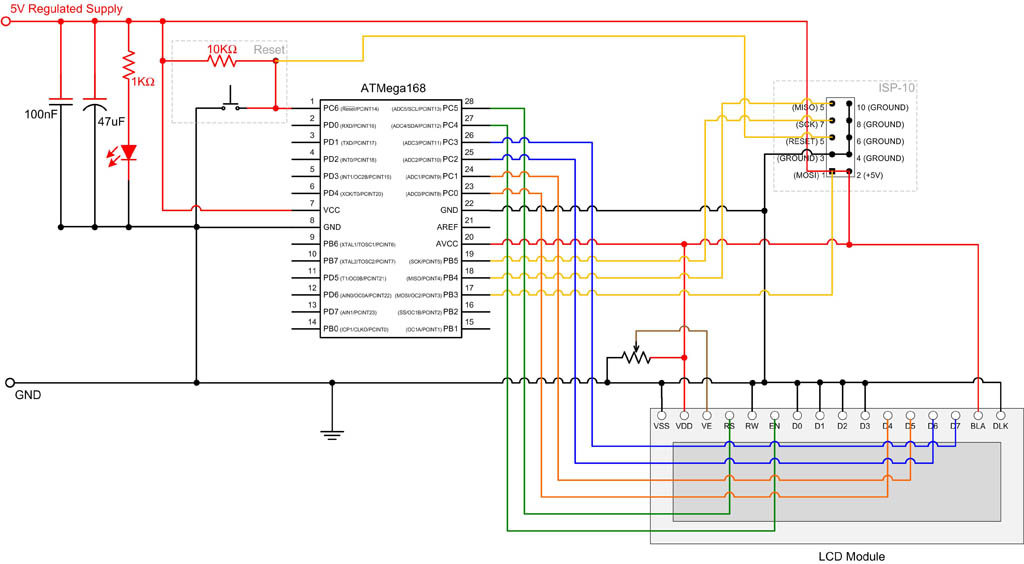
eeprom
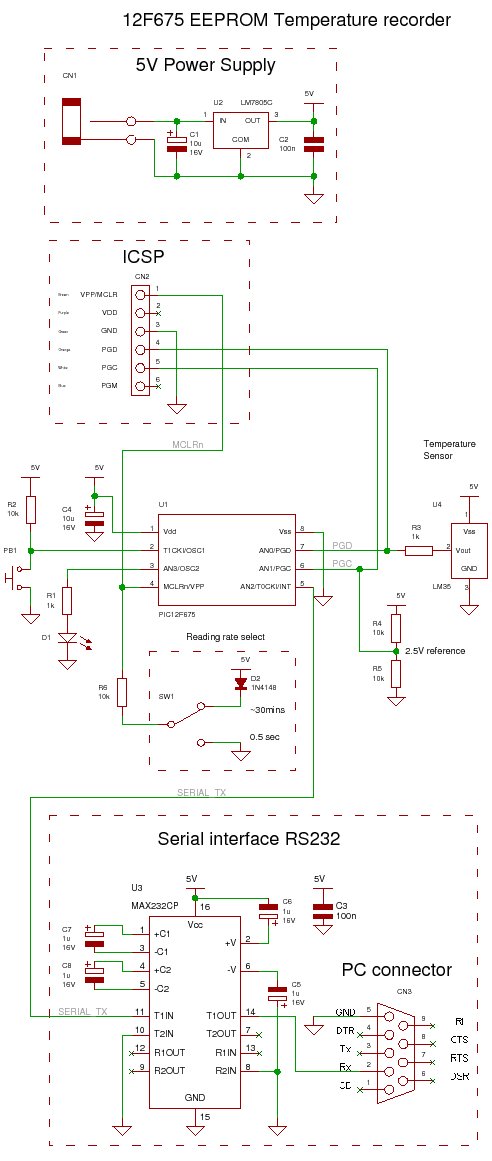
This PIC microcontroller EEPROM project saves temperature data from an LM35DZ IC to the internal long-term data storage of the PIC. The project is similar to the previous one, utilizing nearly the same hardware. It records temperature readings at regular intervals until the storage is full, at which point an LED is activated. The LED serves merely as an indicator of activity and would not typically be used in a real data logger. It is important to note that this project is not optimized for power consumption, making it advisable to power it from a power block. The current consumption is approximately 13mA when the LED is off and 16mA when the LED is on. For battery operation, a rechargeable PP3 battery can be used, but the LED should be omitted. The 12F675 microcontroller may not be the most suitable choice for low-power data logging; a better alternative would be the 16F88, which can adjust its internal oscillator to enter a low-power mode. However, the 12F675 can still be utilized with a slow external 32kHz crystal. Each time an ADC reading is taken, the LED briefly flashes, and with a 500ms reading interval, the readings can be observed. Once 64 readings are accumulated, the LED remains lit, indicating that the data storage is full. It is important to note that only 64 results can be stored due to the requirement of two bytes for each ADC result, resulting in a maximum of 128 bytes of storage. The solderless breadboard and circuit diagram closely resemble those used in the previous project, so if it has already been constructed, only the addition of the blue wire, D2, and R6 is necessary. Upon startup, the LED flashes three times. If the button is held during startup, the LED flashes six times, indicating that the internal EEPROM will be erased to prepare for new temperature logging. Setting GP3 high results in a measurement interval of approximately 30 minutes, while holding it low sets a half-second interval for debugging. The diode D2 is included to prevent programming voltage conflicts during development. If the 12F675 is programmed and then permanently placed in a separate circuit without an ICSP connection, D2 and R6 are no longer needed, allowing pin 4 to be connected to 5V for half-hour readings. The software continuously collects temperature readings, transmitting the results to the serial port as Celsius values while storing them in the EEPROM. It can gather a maximum of 64 readings, which occupy half of the internal EEPROM's capacity. After reaching this limit, the recording process halts, and the readings remain stored in the EEPROM even if power is lost.
This project employs the LM35DZ temperature sensor, which outputs an analog voltage proportional to the temperature in degrees Celsius. The output of the LM35DZ is fed into the analog-to-digital converter (ADC) of the PIC microcontroller, specifically the 12F675. The ADC converts the analog voltage into a digital value that can be processed by the microcontroller. The microcontroller then stores this digital value in its internal EEPROM, which is non-volatile memory, ensuring data retention even during power outages.
The circuit includes an LED that serves as a visual indicator of the system's operation. This LED is controlled by a GPIO pin of the PIC microcontroller, which is programmed to turn the LED on after 64 readings have been stored, signaling that the storage capacity has been reached. Additionally, the circuit design includes a button for initiating the EEPROM erase sequence, allowing for fresh data logging.
For power management, the project operates at a relatively higher current draw, making it less suitable for battery-powered applications unless the LED is omitted. If battery operation is desired, using a rechargeable PP3 battery is recommended. The choice of the 12F675 microcontroller is noted as a limitation for low-power applications, and the 16F88 is suggested for applications requiring lower power consumption.
The implementation of the diode D2 is crucial during the development phase to prevent any potential voltage conflicts that could arise during programming. Once the microcontroller is programmed and removed from the development environment, the diode and resistor can be omitted if the circuit is intended for standalone operation.
Overall, this project serves as a practical demonstration of temperature data logging using a PIC microcontroller, providing a foundational understanding of interfacing sensors, data storage, and basic circuit design principles.This PIC microcontroller EEPROM project saves the temperature from an LM35DZ IC to the PIC`s internal long term data storage area. The project follows on from the last project using the virtually the same hardware. It stores temperature readings internally at regular intervals until full and after this it turns on the LED.
The LED is really just f or showing that something is happening and in a real data logger you would not use it. Note: This project is not optimized for power consumption so the best way to use it is powered from a power block. The current consumed is about 13mA (LED off) 16mA (LED on at end). If you want to use a battery use a rechargeable PP3 and do not attach the LED. The 12F675 may not the best PIC microcontroller to use for low power data logging and a better choice would be the 16F88 as it can change its internal oscillator on the fly going into slow (current saving) mode.
But you could use the 12F675 with a slow external 32kHz crystal. At every ADC reading the LED is flashed briefly and when you select a 500ms reading interval you can see the readings being taken. When 64 readings are accumulated the LED is lit permanently - showing that the data store is full. Note: For this chip you only get to store 64 results as you need to store an unsigned integer for every ADC result and this takes 2 bytes so 128 Bytes/2 = 64 results.
The solderless breadboard and circuit diagram are nearly the same as used in the previous project so if you have already built it you don`t need to do any more. Just add the blue wire, D2 and R6. At start up the led is flashed three times. If you hold the button at start up the LED is flashed six times and the internal EEPROM will be erased ready to start logging the temperature again.
As mentioned before setting GP3 high causes the measurement interval to be approximately 30 minutes whereas holding it low causes a half second measurement interval (for debug). Note the diode D2 is to stop programming voltage conflict during development. If you just program the 12F785 and then put it permanently in a separate circuit with no ICSP connection then D2 and R6 are not required - so you could connect pin 4 to 5V for half hour readings.
The software continuously gathers temperature readings and as before it transmits the result to the serial port (this time as a centigrade reading) and it also stores the reading in the EEPROM. It cangather a maximum of 64 readings (half the size of the internal EEPROM). After this it stops recording and even if the power is lost the readings will remain stored in the EEPROM.
🔗 External reference
This project employs the LM35DZ temperature sensor, which outputs an analog voltage proportional to the temperature in degrees Celsius. The output of the LM35DZ is fed into the analog-to-digital converter (ADC) of the PIC microcontroller, specifically the 12F675. The ADC converts the analog voltage into a digital value that can be processed by the microcontroller. The microcontroller then stores this digital value in its internal EEPROM, which is non-volatile memory, ensuring data retention even during power outages.
The circuit includes an LED that serves as a visual indicator of the system's operation. This LED is controlled by a GPIO pin of the PIC microcontroller, which is programmed to turn the LED on after 64 readings have been stored, signaling that the storage capacity has been reached. Additionally, the circuit design includes a button for initiating the EEPROM erase sequence, allowing for fresh data logging.
For power management, the project operates at a relatively higher current draw, making it less suitable for battery-powered applications unless the LED is omitted. If battery operation is desired, using a rechargeable PP3 battery is recommended. The choice of the 12F675 microcontroller is noted as a limitation for low-power applications, and the 16F88 is suggested for applications requiring lower power consumption.
The implementation of the diode D2 is crucial during the development phase to prevent any potential voltage conflicts that could arise during programming. Once the microcontroller is programmed and removed from the development environment, the diode and resistor can be omitted if the circuit is intended for standalone operation.
Overall, this project serves as a practical demonstration of temperature data logging using a PIC microcontroller, providing a foundational understanding of interfacing sensors, data storage, and basic circuit design principles.This PIC microcontroller EEPROM project saves the temperature from an LM35DZ IC to the PIC`s internal long term data storage area. The project follows on from the last project using the virtually the same hardware. It stores temperature readings internally at regular intervals until full and after this it turns on the LED.
The LED is really just f or showing that something is happening and in a real data logger you would not use it. Note: This project is not optimized for power consumption so the best way to use it is powered from a power block. The current consumed is about 13mA (LED off) 16mA (LED on at end). If you want to use a battery use a rechargeable PP3 and do not attach the LED. The 12F675 may not the best PIC microcontroller to use for low power data logging and a better choice would be the 16F88 as it can change its internal oscillator on the fly going into slow (current saving) mode.
But you could use the 12F675 with a slow external 32kHz crystal. At every ADC reading the LED is flashed briefly and when you select a 500ms reading interval you can see the readings being taken. When 64 readings are accumulated the LED is lit permanently - showing that the data store is full. Note: For this chip you only get to store 64 results as you need to store an unsigned integer for every ADC result and this takes 2 bytes so 128 Bytes/2 = 64 results.
The solderless breadboard and circuit diagram are nearly the same as used in the previous project so if you have already built it you don`t need to do any more. Just add the blue wire, D2 and R6. At start up the led is flashed three times. If you hold the button at start up the LED is flashed six times and the internal EEPROM will be erased ready to start logging the temperature again.
As mentioned before setting GP3 high causes the measurement interval to be approximately 30 minutes whereas holding it low causes a half second measurement interval (for debug). Note the diode D2 is to stop programming voltage conflict during development. If you just program the 12F785 and then put it permanently in a separate circuit with no ICSP connection then D2 and R6 are not required - so you could connect pin 4 to 5V for half hour readings.
The software continuously gathers temperature readings and as before it transmits the result to the serial port (this time as a centigrade reading) and it also stores the reading in the EEPROM. It cangather a maximum of 64 readings (half the size of the internal EEPROM). After this it stops recording and even if the power is lost the readings will remain stored in the EEPROM.
🔗 External reference
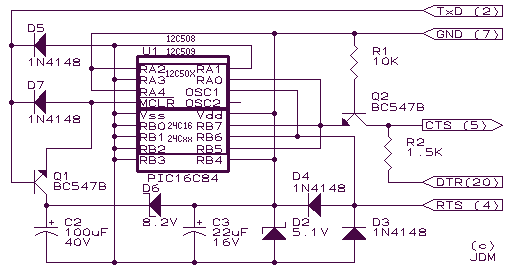
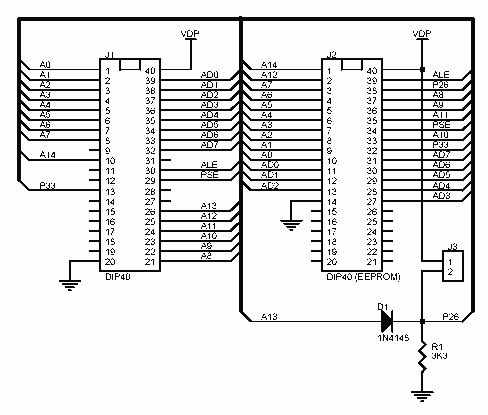

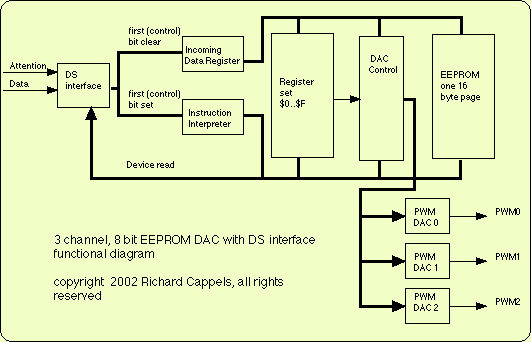
.jpg)
